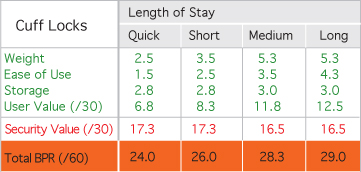Design Responses > About Locks > Typology
Cuff Lock
Cuff locks look and function like a sturdy pair of handcuffs (or in this context wheel, frame and parking furniture cuffs). Typically they are made from hardened steel with a plastic coating to protect the paintwork of bikes. One cuff is secured to the bike frame (or wheel), the other to the parking furniture (or frame).
The cuff diameter can be increased or decreased to accommodate frames, wheels and furniture of different diameters. This adjustability also allows the user to reduce the ‘play’ between the cuff and the object it secures so as to limit the space available for insertion of tools to lever the lock apart. Despite the scope to ‘expand’ a cuff, the maximum diameter is limited and accordingly restricts the diameter of the objects that it can secure.
One shackle alone cannot secure your frame and a wheel together so to secure both wheels and the frame of a bike to a stand would require three cuffs. This solution is best used in combination with ‘secure skewers’ or other means of securing wheels to the frame of the bike.
An additional consideration is the time required to operate the cuffs correctly/securely. One 'set' of cuffs requires two locking actions, one cuff being secured to the bike frame (or wheel), the other to the parking furniture (or frame). This means that they take longer to deploy than other solutions.
Cuff systems are vulnerable to levering and cutting.
Weight
Average weight is 2.17kg.
Dimension
Length from 178-400mm cuff to cuff.
Usability
Cuff diameters restrict versatility. Some cuffs have frame mounts assisting in carriage. Cuff Locks are heavy compared to other solutions.
Keys and Barrel
Barrel and key, pin and key and combination (no key).
Bikeoff Performance Rating
The table below gives a 'user value' out of thirty, in green, and a 'security value' out of thirty, in red. The total value, out of sixty, gives the overall Bikeoff Performance Rating (BPR). If the Bikeoff Performance rating is in green then the lock is 'user biased', a red rating denotes 'security bias' and a yellow rating indicates an equal performance in relation to user and abuser considerations meaning the lock is a 'good all rounder'. Lock performance is also considered in relation to length of stay to indicate how increased risk (more time parked unattended) impacts on user and abuser values, e.g. lighter, and less secure locks will have a much lower BPR for long stops than for quick stops.

Cuff locks display an abuser centred bias: they are robust against attack from thieves but are not very convenient to carry and use. This inconvenience is compensated for in medium and long stay parking situations where the parked bike is exposed to risk of theft for longer periods and therefore security is more of an issue.
Useful References
www.weblinkinfull.com